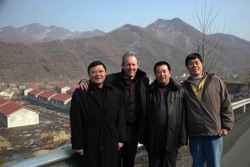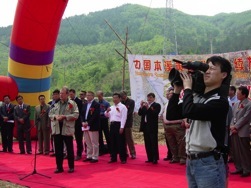
Huangbaiyu A Personal Introduction
I had no idea what it would feel like to live in this one village, to seek a life amongst its residents at a time when external change was upon them. I had prepared as an anthropologist, but not as a person. I felt vulnerable, which I am now sure helped me to be quiet, listen, and look.
Four years ago Huangbaiyu was a place that hardly anyone knew about who didn’t live there. It isn’t even listed on provincial maps of Liaoning. But this small village in the mountains of Northeast China was about to become internationally regarded as a leading solution to the impending global climate crisis. With a master plan for a new eco-town drawn by William McDonough and his firm, McDonough + Partners, advising from Tongji University’s Department of Urban Planning, sponsorship from high levels of government through the Ministry of Science and Technology, the imprimatur of Deng Nan, project management from directors of the China-US Center for Sustainable Development (CUCSD), and with a local businessman at the helm of the real estate development, the new Huangbaiyu that would come into being was showered with accolades, and held up not only as a model for the rest of China, but for development of a green future for a planet in peril.
I lived with the developer, Dai Xiaolong, for a period of time before locating a place in a resident’s home to live for the rest of my days in Huangbaiyu. It turned out that Dai Xiaolong was not a long-time resident of Huangbaiyu, afterall, but a recent arrival. He had businesses located in its ravines and valleys, having bought them through a coordinated sale, and while was viewed with some suspicion by lifetime residents, many came to trust him. His current residence was built after Huangbaiyu was selected by the CUCSD as the location to experiment with building an eco-town in the countryside. It was less of a house and more or a receiving hall and office from which to manage his burgeoning, and hopefully, lucrative relationship with the Chinese leaders and international businessmen who now regularly came through the village to tour its vision of a modern future for the rural poor. I spent many weeks going with Dai to his various business meetings and dinners, his consultations with fortune tellers, and his hours attached to a vibrating belt in the pursuit of a smaller waistline.
Over the next eighteen months, I lived in an area of Huangbaiyu called Dry River Bed. My partner, and now husband, Jay, joined me, and together we slowly became part of the daily rhythm and habits of living of the village. My understanding of the development project, its hopes and its hazards, could only have come from developing relationships with the various persons who had varying stakes in the process of making Huangbaiyu a model of sustainable development. The openness of Intel (a member of the CUCSD Board of Councilors) and the CUCSD staff was invaluable, and enabled me to participate in many CUCSD meetings on the project in both Beijing and Portland, OR. Bill McDonough was generous with his time, and allowed me to see him work not only in Huangbaiyu, but in Hawaii. Through the acts of daily survival, I slowly became part of several of the communities that make up Huangbaiyu: farming the land, teaching at the school, talking about life, love, death, and money with dozens of individuals over the course of months and months. Read more...
I have begun publishing selections from my work on Huangbaiyu, and would appreciate engaging in any conversations they may spark.



Copyright © 2008-2009 Shannon May About me Design Blog Kenya & Life Sundries Blog Contact smay at post dot harvard dot edu
Everything is a work in progress